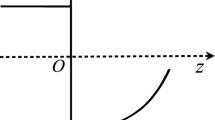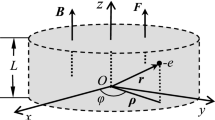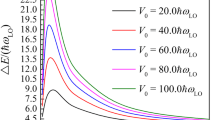Abstract
In this paper, we construct a simple qubit using impurity-center quantum dots with a spherical Gaussian confining potential and analyze the rationality and superiority of this kind of qubit. Based on the Pekar-type variational method, Gaussian entropy and ground-state lifetime expressions under an electromagnetic field environment are derived. The numerical results show that the variation of Gaussian entropy of the system with the change of the quantum dot confinement range presents an inverted asymmetric "Gaussian distribution", and the time evolution of the Gaussian entropy presents the characteristics of plane wave propagation. The oscillation amplitude of Gaussian entropy decreases with increasing the electric field intensity but increases with increasing the magnetic induction intensity. However, the oscillation period of Gaussian entropy increases with increasing the electric field intensity but decreases with increasing the magnetic induction intensity. The ground-state lifetime of the system increases with increasing the well depth of the confining potential and the dielectric constant ratio of the quantum dots but decreases with increasing the confining potential range and electron–phonon coupling constant, respectively. The ground-state lifetime decreases with increasing temperature and electric field intensity, respectively, but increases with increasing the magnetic induction intensity. The conclusions of this paper can provide a reference for constructing the qubit using semiconductor quantum dots, optimizing information storage and transmission, and suppressing decoherence.













Similar content being viewed by others
References
S S Li, X G Wu and H Z Zheng Physics 33 404(2004) (in Chinese)
M Schlosshauer Rev. Mod. Phys. 76 1267(2005)
S S Li et al. J. Appl. Phys. 90 6151 (2001)
J R Petta et al. Science 309 2180(2005)
Y Sun, Z H Ding and J L Xiao J. Electron. Mater. 46 439 (2017)
X F Bai, W Xin and Eerdunchaolu Int J. Mod. Phys. B 33 1950322 (2019)
W Qiu, J L Xiao and CY Cai J. Low Temp. Phys. 198 233(2020)
J L Xiao J. Low Temp. Phys. 202 196 (2021)
W Qiu et al. Iran J. Sci. Technol. A 44 1237 (2020)
C Rajamohan et al. J. Math. Chem. 44 743 (2008)
J L Zhu, J H Zhao and J J Xiong J. Phys. Condense Matter 6 5097 (1994)
S Kang, J Li and T Y Shi J. Phys. B At. Mol. Opt. Phys. 39 6491 (2006)
J L Zhu and X Chen Phys. Rev. B 50 4497 (1994).
J W Yin et al. Acta Phys. Sin. 57 2695 (2008) (in Chinese)
W Xiao and J L Xiao Int. J. Theor. Phys. 55 2936 (2016)
A J Fotue et al. Eur. Phys. J. Plus. 131 205(2016)
Wuyunqimuge, C Han and Eerdunchaolu Acta Phys. Sin. 68 247803(2019)(in Chinese)
Y Sun and J L Xiao Eur. Phys. J. Plus. 135 592 (2020)
X F Bai, Y Zhang and Eerdunchaolu Indian J. Phys. 95 1783 (2021)
A Chatterjee J. Phys. A: Math. Gen. 18 2403(1985)
A Chatterjee Phys. Rep. 186 249 (1990)
W Xie Physica B 403 2828 (2008)
W Xie Phys. Status Solidi (b) 245 101(2008)
Aalu Boda and A Chatterjee Physica E 45 36(2012)
Aalu Boda et al. AIP Conference Proceedings 1665 120035 (2015)
L H Shao et al. Phys. Rev. A 91 042120 (2015)
S Rana, P Parashar and M Lewenstein Phys. Rev. A 93 012110 (2016)
A Streltsov et al. Phys. Rev. Lett. 115 020403 (2015)
J J Ma et al. Phys. Rev. Lett. 116 160407(2016)
G Davide Phys. Rev. Lett. 113 170401(2014)
D P Pires, L C Céleri and D O Soares-Pinto Phys. Rev. A 91 042330(2015)
C E Shannon Bell Syst. Tech. J. 27 379 (1948)
C Tsallis J. Stat. Phys. 52 479 (1988)
A Rényi Math. Stat. Probab. 1 547(1961)
S Seba and M Hanmandlu Neurocomputing 120 214 (2013)
M Tiotsop et al. Superlattice. Microst. 103 70(2017)
M Habibinejad and A Ghanbari J. Low Temp. Phys. 203 369 (2021)
T D Lee, F.M Low and D Pines Phys. Rev. 90 297 (1953)
L D Landau and S I Pekar Zh. Eksp. Teor. Fiz. 18 419(1948)
T Yildirim and A Ercelebi J. Phys. Conden. Matt. 3 1271(1999)
S Susan and M Hanmandlu Neurocomputing 12 2140(2013)
Y F Yu et al. Chin. Phys. B 17 2236(2008)
G Withfield and M Engineer Phys. Rev. B 12 5472 (1975)
H J Li and J L Xiao J. Low Temp. Phys. 168 57 (2012)
Z X Li Indian J. Phys. 93 707(2019)
M Tiotsop, A J Fotue, H B Fotsin and L C Fai Opt Quant Electron 50 365 (2018)
R Khordad and H R R Sedehi Indian J. Phys. 91 825(2017)
Acknowledgements
This work was supported by the scientific research foundation of Hebei Normal University of Science &Technology
Author information
Authors and Affiliations
Corresponding author
Additional information
Publisher's Note
Springer Nature remains neutral with regard to jurisdictional claims in published maps and institutional affiliations.
Rights and permissions
Springer Nature or its licensor (e.g. a society or other partner) holds exclusive rights to this article under a publishing agreement with the author(s) or other rightsholder(s); author self-archiving of the accepted manuscript version of this article is solely governed by the terms of such publishing agreement and applicable law.
About this article
Cite this article
Xin, W. Influence of electromagnetic field on Gaussian entropy and ground-state lifetime in impurity-center quantum dot with spherical Gaussian confining potential. Indian J Phys 97, 3931–3940 (2023). https://doi.org/10.1007/s12648-023-02731-x
Received:
Accepted:
Published:
Issue Date:
DOI: https://doi.org/10.1007/s12648-023-02731-x




